Soyuz T-3
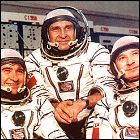 Soyuz T-3 lifts off from the Soviet Union’s Baikonur Cosmodrome launch complex, carrying the first three-man Soviet space crew since the early days of the Soyuz in 1971. Cosmonauts Leonid Kizim, Oleg Makarov and Gennady Strekalov also become the first three-man space station crew since the ill-fated crew of the first Salyut. Over a period of nearly two weeks, the crew conducts extensive repairs and upgrades to Salyut 6, readying the station for its next long-duration crew before departing on December 10th.
Soyuz T-3 lifts off from the Soviet Union’s Baikonur Cosmodrome launch complex, carrying the first three-man Soviet space crew since the early days of the Soyuz in 1971. Cosmonauts Leonid Kizim, Oleg Makarov and Gennady Strekalov also become the first three-man space station crew since the ill-fated crew of the first Salyut. Over a period of nearly two weeks, the crew conducts extensive repairs and upgrades to Salyut 6, readying the station for its next long-duration crew before departing on December 10th.
Soyuz 38
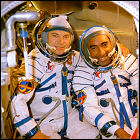 The Soviet Union launches Soyuz 38 on a mission to the Salyut 6 space station, carrying cosmonaut Yuri Romanenko and the first Cuban in space, Arnaldo Tamayo Mendez. The week-long flight includes docking maneuvers with Salyut 6 in pitch blackness, guided only by the lights on both the Soyuz vehicle and the station, and experiments aboard Salyut. Since the long-duration Salyut 6/Soyuz 35 crew is due to leave the station soon, the Soyuz 38 crew departs in the same vehicle in which it arrived.
The Soviet Union launches Soyuz 38 on a mission to the Salyut 6 space station, carrying cosmonaut Yuri Romanenko and the first Cuban in space, Arnaldo Tamayo Mendez. The week-long flight includes docking maneuvers with Salyut 6 in pitch blackness, guided only by the lights on both the Soyuz vehicle and the station, and experiments aboard Salyut. Since the long-duration Salyut 6/Soyuz 35 crew is due to leave the station soon, the Soyuz 38 crew departs in the same vehicle in which it arrived.
Soyuz 37
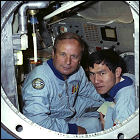 The Soviet Union launches Soyuz 37 on a week-long mission to visit space station Salyut 6. Part of the Interkosmos series, Soyuz 37 carries an international crew consisting of veteran cosmonaut Viktor Gorbatko and the first Vietnamese space traveler, Pham Tuan. Joint experiments are conducted with the long-duration crew of Salyut 6/Soyuz 35, and the Soyuz 37 crew departs in the Soyuz 36 capsule on July 31st, leaving the station crew with a fresh vehicle with which to make their own return home.
The Soviet Union launches Soyuz 37 on a week-long mission to visit space station Salyut 6. Part of the Interkosmos series, Soyuz 37 carries an international crew consisting of veteran cosmonaut Viktor Gorbatko and the first Vietnamese space traveler, Pham Tuan. Joint experiments are conducted with the long-duration crew of Salyut 6/Soyuz 35, and the Soyuz 37 crew departs in the Soyuz 36 capsule on July 31st, leaving the station crew with a fresh vehicle with which to make their own return home.
Soyuz T-2
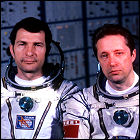 An advanced version of a new Soviet Soyuz spacecraft is launched with a crew for the first time. Soyuz T-2 is launched on a three-day mission to visit the Salyut 6 space station, with its primary goal to test a new automated approach and docking system for use with the Salyut space stations. After spending almost four days in orbit, cosmonauts Yuri Malyshev and Vladimir Aksyonov return to Earth; due to their vehicle’s flight test status, the T-2 crew does not swap spacecraft with the Salyut 6/Soyuz 35 crew.
An advanced version of a new Soviet Soyuz spacecraft is launched with a crew for the first time. Soyuz T-2 is launched on a three-day mission to visit the Salyut 6 space station, with its primary goal to test a new automated approach and docking system for use with the Salyut space stations. After spending almost four days in orbit, cosmonauts Yuri Malyshev and Vladimir Aksyonov return to Earth; due to their vehicle’s flight test status, the T-2 crew does not swap spacecraft with the Salyut 6/Soyuz 35 crew.
Soyuz 36
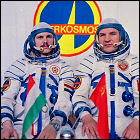 Soyuz 36 is launched by the Soviet Union on a one-week mission to space station Salyut 6. The crew consists of Apollo-Soyuz veteran Valery Kubasov and the first Hungarian in space, Bertalan Farkas. During the crew’s week-long visit to Salyut 6, they undertake an exhaustingly jam-packed series of experiments before swapping Soyuz vehicles with the long-duration station crew – technically, the Soyuz 36 crew returns in the Soyuz 35 vehicle on June 6th.
Soyuz 36 is launched by the Soviet Union on a one-week mission to space station Salyut 6. The crew consists of Apollo-Soyuz veteran Valery Kubasov and the first Hungarian in space, Bertalan Farkas. During the crew’s week-long visit to Salyut 6, they undertake an exhaustingly jam-packed series of experiments before swapping Soyuz vehicles with the long-duration station crew – technically, the Soyuz 36 crew returns in the Soyuz 35 vehicle on June 6th.
Soyuz 35
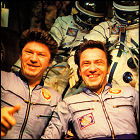 The Soviet Union launches Soyuz 35 en route to space station Salyut 6 for a long-duration stay. Cosmonauts Leonid Popov and Valery Ryumin set a new space endurance record with their 185-day stay, lasting until October 1980. Ryumin had been a member of the last Salyut 6 crew as well, having stayed on the station for six months in 1979, and was not originally scheduled for this mission, rotated into the prime crew due to the illness of the originally assigned crew member. Four other crews visit Salyut 6 during the Soyuz 35 crew’s stay. By the end of this mission, Ryumin holds a personal record for the most time accrued in space by a human being – 352 days, barely two weeks short of a full year of spaceflight experience.
The Soviet Union launches Soyuz 35 en route to space station Salyut 6 for a long-duration stay. Cosmonauts Leonid Popov and Valery Ryumin set a new space endurance record with their 185-day stay, lasting until October 1980. Ryumin had been a member of the last Salyut 6 crew as well, having stayed on the station for six months in 1979, and was not originally scheduled for this mission, rotated into the prime crew due to the illness of the originally assigned crew member. Four other crews visit Salyut 6 during the Soyuz 35 crew’s stay. By the end of this mission, Ryumin holds a personal record for the most time accrued in space by a human being – 352 days, barely two weeks short of a full year of spaceflight experience.
Soyuz 34: ghost rider in the sky
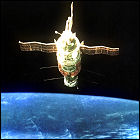 The Soviet Union launches a redesigned vehicle, Soyuz 34, with no crew aboard. Under automated control, Soyuz 34 docks with space station Salyut 6, where it provides cosmonauts Vladimir Lyakhov and Valery Ryumin with a more reliable return capsule. Their original vehicle Soyuz 32 capsule is loaded with material to be returned to Earth, and it lands – unoccupied and without incident – on June 13th, and the station crew returns to Earth aboard Soyuz 34 in August.
The Soviet Union launches a redesigned vehicle, Soyuz 34, with no crew aboard. Under automated control, Soyuz 34 docks with space station Salyut 6, where it provides cosmonauts Vladimir Lyakhov and Valery Ryumin with a more reliable return capsule. Their original vehicle Soyuz 32 capsule is loaded with material to be returned to Earth, and it lands – unoccupied and without incident – on June 13th, and the station crew returns to Earth aboard Soyuz 34 in August.
Soyuz 33: Soviet space snafu
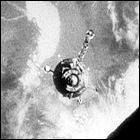 The Soviet Union launches Soyuz 33, intended to take cosmonauts Nikolai Rukavishnikov and Georgi Ivanov (the latter of whom is the first Bulgarian space traveler) to space station Salyut 6. But Soyuz 33 never reaches its destination. At a distance of 3,000 feet from Salyut, Soyuz 33’s main engine fails to fire – the first time such a failure has ever occurred in over a decade of Soyuz flights. Soyuz 33 is recalled to Earth at the earliest opportunity, leaving the station crew with no visits from any other human beings during their two-man, 175-day stay in orbit. It is later discovered that Soyuz 33’s engine could have exploded, causing critical damage to the entire vehicle – and ground controllers now focus their attention on Soyuz 32, docked at Salyut with an engine of identical design which could also fail.
The Soviet Union launches Soyuz 33, intended to take cosmonauts Nikolai Rukavishnikov and Georgi Ivanov (the latter of whom is the first Bulgarian space traveler) to space station Salyut 6. But Soyuz 33 never reaches its destination. At a distance of 3,000 feet from Salyut, Soyuz 33’s main engine fails to fire – the first time such a failure has ever occurred in over a decade of Soyuz flights. Soyuz 33 is recalled to Earth at the earliest opportunity, leaving the station crew with no visits from any other human beings during their two-man, 175-day stay in orbit. It is later discovered that Soyuz 33’s engine could have exploded, causing critical damage to the entire vehicle – and ground controllers now focus their attention on Soyuz 32, docked at Salyut with an engine of identical design which could also fail.
Soyuz 32
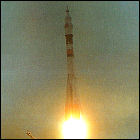 The Soviet Union launches Soyuz 32 on a long-duration mission to space station Salyut 6, with cosmonauts Vladimir Lyakhov and Valery Ryumin aboard. Over a record-setting 175 days, the new station crew conducts necessary repairs and upgrades to the station’s hardware, as well as conducting various experiments. With the arrival of equipment sent in the unmanned Progress 5 freighter in March, this is the first space crew to have a means to see ground controllers via a video link, rather than talking to them via radio; the cosmonauts also look forward to seeing family members during planned teleconferences. This is also the first crew to vacation in space, permitted a five-day break over May Day. Due to a major technical problem in the next manned Soyuz flight, the crew of Salyut 7 sets its duration record without a single visit from another cosmonaut.
The Soviet Union launches Soyuz 32 on a long-duration mission to space station Salyut 6, with cosmonauts Vladimir Lyakhov and Valery Ryumin aboard. Over a record-setting 175 days, the new station crew conducts necessary repairs and upgrades to the station’s hardware, as well as conducting various experiments. With the arrival of equipment sent in the unmanned Progress 5 freighter in March, this is the first space crew to have a means to see ground controllers via a video link, rather than talking to them via radio; the cosmonauts also look forward to seeing family members during planned teleconferences. This is also the first crew to vacation in space, permitted a five-day break over May Day. Due to a major technical problem in the next manned Soyuz flight, the crew of Salyut 7 sets its duration record without a single visit from another cosmonaut.
Soyuz 31
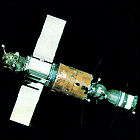 The Soviet Union’s Soyuz 31 mission to the Salyut 6 space station lifts off, with cosmonauts Valery Bykovsky and Sigmund Jahn (the first East German space traveler) aboard. The crews are segregated less than on previous Interkosmos flights, and the Soyuz 31 crew is in space for over a week. They leave their vehicle at Salyut 6 and return in the Soyuz 29 vehicle on September 3rd.
The Soviet Union’s Soyuz 31 mission to the Salyut 6 space station lifts off, with cosmonauts Valery Bykovsky and Sigmund Jahn (the first East German space traveler) aboard. The crews are segregated less than on previous Interkosmos flights, and the Soyuz 31 crew is in space for over a week. They leave their vehicle at Salyut 6 and return in the Soyuz 29 vehicle on September 3rd.
Soyuz 30
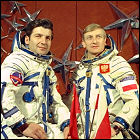 Soyuz 30 lifts off en route to a brief visit with the crew of space station Salyut 6. This is the second manned Interkosmos mission, with cosmonaut Pyotr Klimuk and the first Polish cosmonaut, Mirosław Hermaszewski, aboard. They dock at Salyut 6 after two days in orbit, and spend a total of eight days in space. Though some joint experiments are conducted among the four occupants of the station, the Soyuz 30 crew frequently has to perform experiments in its own Soyuz vehicle to avoid getting in the station crew’s way, and the mission is kept short to free up the second docking port for a Progress unmanned supply vehicle launched four days after Soyuz 30 returns to Earth.
Soyuz 30 lifts off en route to a brief visit with the crew of space station Salyut 6. This is the second manned Interkosmos mission, with cosmonaut Pyotr Klimuk and the first Polish cosmonaut, Mirosław Hermaszewski, aboard. They dock at Salyut 6 after two days in orbit, and spend a total of eight days in space. Though some joint experiments are conducted among the four occupants of the station, the Soyuz 30 crew frequently has to perform experiments in its own Soyuz vehicle to avoid getting in the station crew’s way, and the mission is kept short to free up the second docking port for a Progress unmanned supply vehicle launched four days after Soyuz 30 returns to Earth.
Soyuz 29
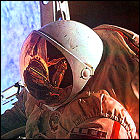 The Soviet Union launches Soyuz 29 on a mission to berth at space station Salyut 6 for a period of around four months. Cosmonauts Vladimir Kovalyonok and Aleksandr Ivanchenkov are aboard, and they eventually set a new space endurance record, remaining in orbit for 139 days. Numerous material science experiments are carried out, as well as a spacewalk to retrieve samples of various materials left exposed to space outside the station. The crew is also assigned to take on a more rigorous exercise program. They will return to Earth in November after swapping vehicles with the crew of Soyuz 31.
The Soviet Union launches Soyuz 29 on a mission to berth at space station Salyut 6 for a period of around four months. Cosmonauts Vladimir Kovalyonok and Aleksandr Ivanchenkov are aboard, and they eventually set a new space endurance record, remaining in orbit for 139 days. Numerous material science experiments are carried out, as well as a spacewalk to retrieve samples of various materials left exposed to space outside the station. The crew is also assigned to take on a more rigorous exercise program. They will return to Earth in November after swapping vehicles with the crew of Soyuz 31.
Soyuz 28
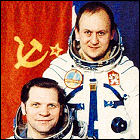 The Soviet Union launches the Soyuz 28 mission, the first manned flight in its Interkosmos series of international space missions. Cosmonaut Vladimír Remek is the first Czech in space, as well as the first space traveler not born in the Soviet Union or the United States; along with Soyuz 28 mission commander Alexei Gubarev, Remek visits the Salyut 6 space station for several days, though is presence is purely political showmanship; Remek later reveals that he had few actual functions to perform during the flight. Soyuz 28 spends a total of nearly eight days in space before returning to Earth.
The Soviet Union launches the Soyuz 28 mission, the first manned flight in its Interkosmos series of international space missions. Cosmonaut Vladimír Remek is the first Czech in space, as well as the first space traveler not born in the Soviet Union or the United States; along with Soyuz 28 mission commander Alexei Gubarev, Remek visits the Salyut 6 space station for several days, though is presence is purely political showmanship; Remek later reveals that he had few actual functions to perform during the flight. Soyuz 28 spends a total of nearly eight days in space before returning to Earth.
Soyuz 27
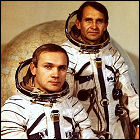 The Soviet Union launches Soyuz 27 on a mission to the Salyut 6 space station – the first instance of three vehicles being docked together in space. Cosmonauts Vladimir Dzhanibekov and Oleg Makarov spend six days with the crew of Soyuz 26 board the station, although Dzhanibekov and Makarov swap capsules with the station crew, leaving the newer vehicle at the station for their eventual return. The crew of Soyuz 27 is in space for less than a week, but their spacecraft remains in orbit, connected to Salyut, for over two months.
The Soviet Union launches Soyuz 27 on a mission to the Salyut 6 space station – the first instance of three vehicles being docked together in space. Cosmonauts Vladimir Dzhanibekov and Oleg Makarov spend six days with the crew of Soyuz 26 board the station, although Dzhanibekov and Makarov swap capsules with the station crew, leaving the newer vehicle at the station for their eventual return. The crew of Soyuz 27 is in space for less than a week, but their spacecraft remains in orbit, connected to Salyut, for over two months.
Soyuz 26
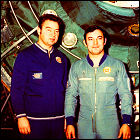 A two-man crew – cosmonauts Yuri Romanenko and Georgi Grechko – is launched aboard Soyuz 26 by the Soviet Union. The Soyuz capsule docks with the recently-launched Salyut 6 space station, and the crew takes up residence for over three months, setting a new space endurance record at 96 days. The Soyuz 27 crew visits in January and swaps vehicles with the station occupants, meaning that Romanenko and Grechko technically return to Earth aboard Soyuz 27 in March 1978. Ten days into the mission, the first Soviet spacewalk since 1969 is undertaken to examine the forward docking hatch of Salyut 6, with which the previous mission failed to connect. This spacewalk was the first outing of the Soviet-made Orlan spacesuit, a design still in use on the International Space Station in the 21st century.
A two-man crew – cosmonauts Yuri Romanenko and Georgi Grechko – is launched aboard Soyuz 26 by the Soviet Union. The Soyuz capsule docks with the recently-launched Salyut 6 space station, and the crew takes up residence for over three months, setting a new space endurance record at 96 days. The Soyuz 27 crew visits in January and swaps vehicles with the station occupants, meaning that Romanenko and Grechko technically return to Earth aboard Soyuz 27 in March 1978. Ten days into the mission, the first Soviet spacewalk since 1969 is undertaken to examine the forward docking hatch of Salyut 6, with which the previous mission failed to connect. This spacewalk was the first outing of the Soviet-made Orlan spacesuit, a design still in use on the International Space Station in the 21st century.
Soyuz 25
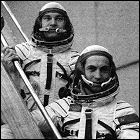 The Soviet Union launches Soyuz 25 into Earth orbit, with cosmonauts Vladimir Kovalyonok and Valery Ryumin set to become the first occupants of the new Salyut 6 space station. However, the crew is unable to successfully dock Soyuz 25 to Salyut 6, and after a fifth attempt to dock, the mission is aborted and the cosmonauts are recalled to Earth due to concerns about the remaining fuel in their vehicle. As a result, Soyuz 25 is the last all-rookie Soviet space crew until the 1990s.
The Soviet Union launches Soyuz 25 into Earth orbit, with cosmonauts Vladimir Kovalyonok and Valery Ryumin set to become the first occupants of the new Salyut 6 space station. However, the crew is unable to successfully dock Soyuz 25 to Salyut 6, and after a fifth attempt to dock, the mission is aborted and the cosmonauts are recalled to Earth due to concerns about the remaining fuel in their vehicle. As a result, Soyuz 25 is the last all-rookie Soviet space crew until the 1990s.
Soyuz 24
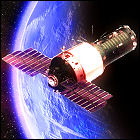 The Soviet Union launches the Soyuz 24 mission to the Salyut 5 military space station. Cosmonauts Viktor Gorbatko and Yuri Glazkov carry special breathing gear to protect them from toxic fumes reported to have been the cause of the hasty exit of the crew of Soyuz 21 in 1976. They vent the entire atmosphere of Salyut 5 into space and replenish it, taking up residence for 18 days, during which they perform their own science and Earth surveillance experiments. They leave the station habitable for a visit by another crew, but Salyut 5’s fuel will be exhausted before that mission can take place.
The Soviet Union launches the Soyuz 24 mission to the Salyut 5 military space station. Cosmonauts Viktor Gorbatko and Yuri Glazkov carry special breathing gear to protect them from toxic fumes reported to have been the cause of the hasty exit of the crew of Soyuz 21 in 1976. They vent the entire atmosphere of Salyut 5 into space and replenish it, taking up residence for 18 days, during which they perform their own science and Earth surveillance experiments. They leave the station habitable for a visit by another crew, but Salyut 5’s fuel will be exhausted before that mission can take place.
Soyuz 23: Soviet surprise splashdown!
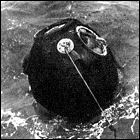 The Soviet Union’s Soyuz 23 mission lifts off from Baikonur Cosmodrome, intended for a stay of up to three months at the Salyut 5 space station. A serious malfunction of the automatic rendezvous gear forces an abort of the docking with the station, and cosmonauts Vyacheslav Zudov and Valery Rozhdestvensky are recalled to Earth, ending their orbit after just two days. But blizzard conditions near the landing site blow the Soyuz crew capsule off-course, resulting in the first-ever splashdown of the normally land-locked Soviet space program as Soyuz 23 plunges through the frozen surface of a lake. With their vehicle intact and functioning, the cosmonauts have to wait nine hours underwater for rescuers to bring the capsule to dry land.
The Soviet Union’s Soyuz 23 mission lifts off from Baikonur Cosmodrome, intended for a stay of up to three months at the Salyut 5 space station. A serious malfunction of the automatic rendezvous gear forces an abort of the docking with the station, and cosmonauts Vyacheslav Zudov and Valery Rozhdestvensky are recalled to Earth, ending their orbit after just two days. But blizzard conditions near the landing site blow the Soyuz crew capsule off-course, resulting in the first-ever splashdown of the normally land-locked Soviet space program as Soyuz 23 plunges through the frozen surface of a lake. With their vehicle intact and functioning, the cosmonauts have to wait nine hours underwater for rescuers to bring the capsule to dry land.
Soyuz 22
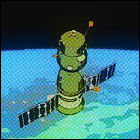 The Soviet Union launches Soyuz 22, a vehicle originally built as a backup for the Apollo-Soyuz Test Project. Unusually, the vehicle does not dock at the recently-launched Salyut 5 space station, but is instead placed in an unusual orbit that happens to make it easy to monitor a major NATO exercise near Norway. Cosmonauts Valery Bykovsky and Vladimir Aksyonov remain in that orbit for nearly eight days before returning to Earth.
The Soviet Union launches Soyuz 22, a vehicle originally built as a backup for the Apollo-Soyuz Test Project. Unusually, the vehicle does not dock at the recently-launched Salyut 5 space station, but is instead placed in an unusual orbit that happens to make it easy to monitor a major NATO exercise near Norway. Cosmonauts Valery Bykovsky and Vladimir Aksyonov remain in that orbit for nearly eight days before returning to Earth.
Abandon ship!: Soyuz 21’s hasty return
 42 days into their stay aboard the military space station Salyut 5, Soviet cosmonauts Boris Volynov and Vitaly Zholobov report unusual odors in the station’s air. On the 49th day of their stay, the two men bundle into their Soyuz 21 capsule to return home on only 10 hours’ notice, an unprecedented event. Details of the causes of the emergency return remain closely guarded to this day, including the possibility of toxic gas escaping into the station’s atmosphere and causing one or both cosmonauts to suffer rapidly deteriorating health. Neither of them fly in space again after their return.
42 days into their stay aboard the military space station Salyut 5, Soviet cosmonauts Boris Volynov and Vitaly Zholobov report unusual odors in the station’s air. On the 49th day of their stay, the two men bundle into their Soyuz 21 capsule to return home on only 10 hours’ notice, an unprecedented event. Details of the causes of the emergency return remain closely guarded to this day, including the possibility of toxic gas escaping into the station’s atmosphere and causing one or both cosmonauts to suffer rapidly deteriorating health. Neither of them fly in space again after their return.
Soyuz 21
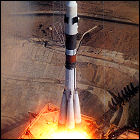 The Soviet Union launches cosmonauts Boris Volynov and Vitaly Zholobov aboard Soyuz 21, the first mission to the newly-orbited Salyut 5 military space station. Though a few scientific experiments are conducted, most of the crew’s activities involve military surveillance of Earth. The crew’s stay is intended to last as long as two months, though an emergency aboard the station will cut that stay short.
The Soviet Union launches cosmonauts Boris Volynov and Vitaly Zholobov aboard Soyuz 21, the first mission to the newly-orbited Salyut 5 military space station. Though a few scientific experiments are conducted, most of the crew’s activities involve military surveillance of Earth. The crew’s stay is intended to last as long as two months, though an emergency aboard the station will cut that stay short.
Apollo-Soyuz and Soyuz 19
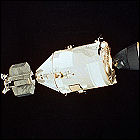 The final launch of an Apollo spacecraft takes place as the last Saturn rocket carries the American component of the Apollo-Soyuz Test Project into orbit. A cooperative international mission intended to see the Apollo capsule dock with a Soviet-launched Soyuz, the ASTP will be the last Apollo flight as the push toward the reusable Space Shuttle takes over NASA’s resources and planning. Aboard the Apollo command/service module are Commander Thomas Stafford, command module pilot Vance Brand, and docking module pilot Deke Slayton, the last of the seven original Mercury astronauts to reach space (heart conditions have prevented him from taking part in a mission until now). Soyuz 19, carrying cosmonauts Alexei Leonov and Valery Kubasov, lifts off a few hours earlier.
The final launch of an Apollo spacecraft takes place as the last Saturn rocket carries the American component of the Apollo-Soyuz Test Project into orbit. A cooperative international mission intended to see the Apollo capsule dock with a Soviet-launched Soyuz, the ASTP will be the last Apollo flight as the push toward the reusable Space Shuttle takes over NASA’s resources and planning. Aboard the Apollo command/service module are Commander Thomas Stafford, command module pilot Vance Brand, and docking module pilot Deke Slayton, the last of the seven original Mercury astronauts to reach space (heart conditions have prevented him from taking part in a mission until now). Soyuz 19, carrying cosmonauts Alexei Leonov and Valery Kubasov, lifts off a few hours earlier.
Soyuz 18
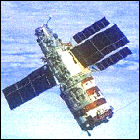 Soyuz 18 is launched toward space station Salyut 4 by the Soviet Union. Cosmonauts Pyotr Klimuk and Vitali Sevastyanov set a new Soviet record for long-duration stays in space, remaining about Salyut 4 for two months. They are also aboard Salyut 4 during the entirety of the Apollo-Soyuz Test Project, and are able to contact that international mission’s Soviet crew in another Soyuz vehicle. (Two mission control centers are used to prevent any confusion between the two Soyuz crews.) At the time the Soyuz 18 crew abandons Salyut 4 in July, the station’s environmental systems are failing, allowing the atmosphere inside the station to become humid enough for mold to begin growing on surfaces in the crew compartment; no further human crews will visit the station.
Soyuz 18 is launched toward space station Salyut 4 by the Soviet Union. Cosmonauts Pyotr Klimuk and Vitali Sevastyanov set a new Soviet record for long-duration stays in space, remaining about Salyut 4 for two months. They are also aboard Salyut 4 during the entirety of the Apollo-Soyuz Test Project, and are able to contact that international mission’s Soviet crew in another Soyuz vehicle. (Two mission control centers are used to prevent any confusion between the two Soyuz crews.) At the time the Soyuz 18 crew abandons Salyut 4 in July, the station’s environmental systems are failing, allowing the atmosphere inside the station to become humid enough for mold to begin growing on surfaces in the crew compartment; no further human crews will visit the station.
Soyuz 18a: “The April 5th Anomaly”
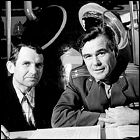 The two-man crew selected to become the second group of occupants for the Soviet Union’s Salyut 4 space station nearly rockets into disaster. Interstage connectors, intended to open simultaneously to allow the third stage of the booster to carry the Soyuz spacecraft into orbit, fail to open on cue, leaving the third stage dragging the dead weight of the spent second stage, changing the trajectory of the entire vehicle. The Soyuz capsule carrying cosmonauts Vasili Lazarev and Oleg Makarov is blasted free, and the two men experience acceleration of 23 Gs as the capsule roars toward a bruisingly rough emergency landing. As if that’s not bad enough, the Soyuz capsule lands perilously close to the USSR’s border with China, and rescue crews spend over 24 hours looking for the crew. The usually secretive Soviet space agency reluctantly reveals details of the mission to NASA, with whom they are collaborating ahead of the historic Apollo-Soyuz joint launch.
The two-man crew selected to become the second group of occupants for the Soviet Union’s Salyut 4 space station nearly rockets into disaster. Interstage connectors, intended to open simultaneously to allow the third stage of the booster to carry the Soyuz spacecraft into orbit, fail to open on cue, leaving the third stage dragging the dead weight of the spent second stage, changing the trajectory of the entire vehicle. The Soyuz capsule carrying cosmonauts Vasili Lazarev and Oleg Makarov is blasted free, and the two men experience acceleration of 23 Gs as the capsule roars toward a bruisingly rough emergency landing. As if that’s not bad enough, the Soyuz capsule lands perilously close to the USSR’s border with China, and rescue crews spend over 24 hours looking for the crew. The usually secretive Soviet space agency reluctantly reveals details of the mission to NASA, with whom they are collaborating ahead of the historic Apollo-Soyuz joint launch.
Soyuz 17
 Soyuz 17 is launched by the Soviet Union, carring cosmonauts Alexei Gubarev and Georgi Grechko to the Salyut 4 space station. The two men move into the station for a month-long stay, breaking the previous Soviet space record, and proceed to conduct several science experiments. Discovering that the mirror of Salyut 4’s on-board telescope is warped, the crew resurfaces it in orbit and repairs the telescope. When Soyuz 17 returns to Earth, the crew is in for one of the bumpiest landings of the Soviet space program to date, landing in a blizzard with 45mph winds at ground level. Despite this, the vehicle lands safely and the crew is not injured.
Soyuz 17 is launched by the Soviet Union, carring cosmonauts Alexei Gubarev and Georgi Grechko to the Salyut 4 space station. The two men move into the station for a month-long stay, breaking the previous Soviet space record, and proceed to conduct several science experiments. Discovering that the mirror of Salyut 4’s on-board telescope is warped, the crew resurfaces it in orbit and repairs the telescope. When Soyuz 17 returns to Earth, the crew is in for one of the bumpiest landings of the Soviet space program to date, landing in a blizzard with 45mph winds at ground level. Despite this, the vehicle lands safely and the crew is not injured.
Soyuz 16
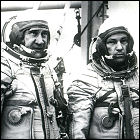 The Soviet Union launches Soyuz 16, a six-day manned space mission to test modifications to the Soyuz vehicle design ahead of 1975‘s Apollo-Soyuz Test Project international flight. Cosmonauts Anatoly Filipchenko and Nikolai Rukavishnikov test the new Soyuz docking mechanism and solar panels, and new rendezvous/docking equipment intended to assist with the Apollo-Soyuz flight as well as to prevent “wasted” missions such as Soyuz 15.
The Soviet Union launches Soyuz 16, a six-day manned space mission to test modifications to the Soyuz vehicle design ahead of 1975‘s Apollo-Soyuz Test Project international flight. Cosmonauts Anatoly Filipchenko and Nikolai Rukavishnikov test the new Soyuz docking mechanism and solar panels, and new rendezvous/docking equipment intended to assist with the Apollo-Soyuz flight as well as to prevent “wasted” missions such as Soyuz 15.
Soyuz 15
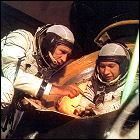 The Soviet space program continues with the launch of Soyuz 15, carrying cosmonauts Lev Dyomin and Gennadi Sarafanov. This is intended to be the second crew to occupy the Salyut 3 military space station, but spacecraft systems intended to automate the rendezvous and docking process fail. After manual dockings are attempted, the Soyuz vehicle is running low on fuel and the crew is recalled to Earth after only two days. (Trying to dodge questions about the nature of Salyut 3’s mission objectives, Soviet space authorities later claim that Soyuz 15 was never going to dock with the station.) No further crews are sent to board Salyut 3.
The Soviet space program continues with the launch of Soyuz 15, carrying cosmonauts Lev Dyomin and Gennadi Sarafanov. This is intended to be the second crew to occupy the Salyut 3 military space station, but spacecraft systems intended to automate the rendezvous and docking process fail. After manual dockings are attempted, the Soyuz vehicle is running low on fuel and the crew is recalled to Earth after only two days. (Trying to dodge questions about the nature of Salyut 3’s mission objectives, Soviet space authorities later claim that Soyuz 15 was never going to dock with the station.) No further crews are sent to board Salyut 3.
Soyuz 14
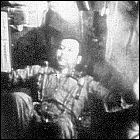 The Soviet Union launches the Soyuz 14 mission, sending cosmonauts Yuri Artyukhin and Pavel Popovich to embark on a two-week stay aboard the Salyut 3 military space station. Though some medical science experiments are performed at Salyut 3, the majority of the crew’s time is taken up with observations of the Earth’s surface, essentially making Salyut 3 the first manned military surveillance satellite. Before leaving, the crew of two offloads supplies so that the new Salyut 3 crew can stay for several months.
The Soviet Union launches the Soyuz 14 mission, sending cosmonauts Yuri Artyukhin and Pavel Popovich to embark on a two-week stay aboard the Salyut 3 military space station. Though some medical science experiments are performed at Salyut 3, the majority of the crew’s time is taken up with observations of the Earth’s surface, essentially making Salyut 3 the first manned military surveillance satellite. Before leaving, the crew of two offloads supplies so that the new Salyut 3 crew can stay for several months.
Soyuz 13
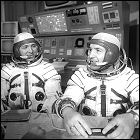 Cosmonauts Pyotr Klimuk and Valentin Lebedev lift off aboard Soyuz 13, the second proving flight of the redesigned Soyuz spacecraft. Their eight-day-long stay in Earth orbit is a Soviet space program rarity: a flight devoted solely to scientific observations with no military objectives. Many of the science experiments were originally intended to be conducted on board the Salyut 1 space station. Much like the Skylab 4 crew, which is in orbit at the same time, the Soyuz 13 crew is able to observe Comet Kohoutek.
Cosmonauts Pyotr Klimuk and Valentin Lebedev lift off aboard Soyuz 13, the second proving flight of the redesigned Soyuz spacecraft. Their eight-day-long stay in Earth orbit is a Soviet space program rarity: a flight devoted solely to scientific observations with no military objectives. Many of the science experiments were originally intended to be conducted on board the Salyut 1 space station. Much like the Skylab 4 crew, which is in orbit at the same time, the Soyuz 13 crew is able to observe Comet Kohoutek.
Soyuz 12: the USSR returns to space
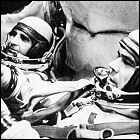 After two years of reorganization and rethinking, the Soviet manned space program resumes with the launch of Soyuz 12, carrying cosmonauts Vasili Lazarev and Oleg Makarov. Previously a three-seater, Soyuz has been redesigned following the Soyuz 11 tragedy: the vehicle now seats a crew of two, both wearing fully pressurized spacesuits. Originally intended to visit the Salyut 2 station, Soyuz 12 is only a two-day shakedown flight for the redesigned spacecraft (Salyut 2’s own technical problems have rendered it uninhabitable by a human crew).
After two years of reorganization and rethinking, the Soviet manned space program resumes with the launch of Soyuz 12, carrying cosmonauts Vasili Lazarev and Oleg Makarov. Previously a three-seater, Soyuz has been redesigned following the Soyuz 11 tragedy: the vehicle now seats a crew of two, both wearing fully pressurized spacesuits. Originally intended to visit the Salyut 2 station, Soyuz 12 is only a two-day shakedown flight for the redesigned spacecraft (Salyut 2’s own technical problems have rendered it uninhabitable by a human crew).